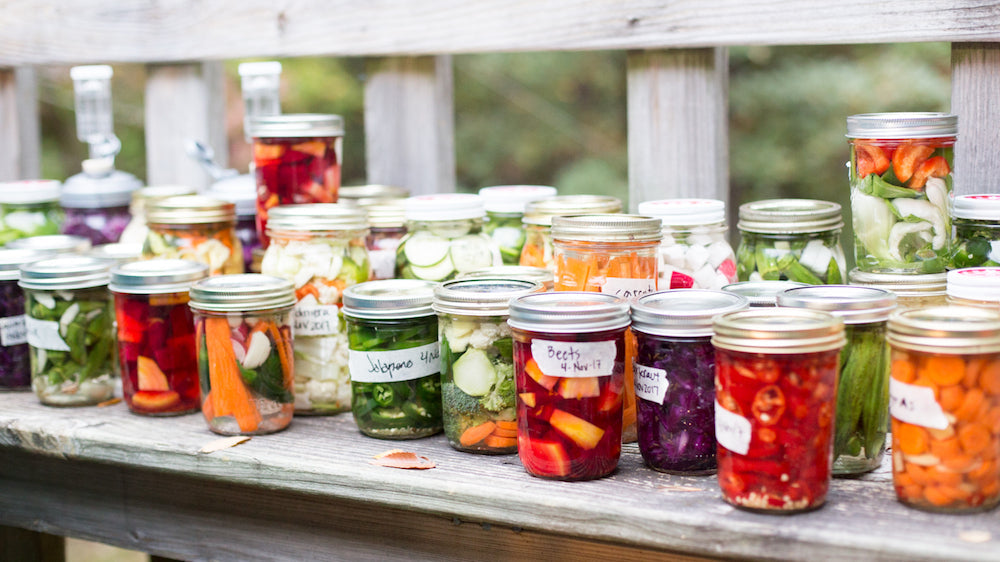News
Beginner’s Guide to Fermenting Food

Fermented food has been part of the human diet for hundreds of years. Sometimes referred to as ‘nature’s cooking process’, fermentation is used to give food a longer shelf life, enhance flavour and remove harmful toxins. You may already be consuming fermented food without realising it. Staples such as tea, bread, wine, cheese and chocolate are all made through processes of fermentation.
How food fermentation works
Fermentation is a natural process. It happens when microorganisms like yeast or bacteria, convert carbs (eg. starch and sugar) into acids or alcohol. The acids or alcohol then serve as a natural preservative, giving fermented food a unique zesty flavour.

Image: hollandandbarret.com
Nutritional benefits of fermented food
A lot of fermented foods naturally contain probiotics, which are commonly known as ‘friendly’ bacteria for the gut, believed to assist digestion. Good bacteria help produce many vitamins needed in the body such as vitamins K, B1, B2, B3, B5, B6 and B12. As well as this, fermentation can make vitamins and minerals more readily available for the body to absorb.
Difference between fermenting and pickling
Pickling is a great way to preserve food for months but it’s not the same as fermenting. Pickles, like the ones you find in your local store, are preserved in an acidic liquid such as vinegar. While vinegar is a fermented product, the pickles are not fermented. This means they won’t necessarily carry the same nutritional and digestive benefits as fermented food.
Fermenting your Click & Grow herbs
It’s easy to create a delicious fermented herb paste using herbs grown in your smart garden. Fermenting gives fresh herbs a tangy, intense flavour that can be great to experiment with. By fermenting them, you can maintain a lot of their sharp flavour and enjoy the probiotic benefits that come from the fermentation process.
Here are some herbs from our collection that you can use to make a fermented herb paste:
Ingredients
- 2 or 3 bunches of your chosen fresh herbs
- ½ teaspoon sea salt
Instructions
- Remove herb leaves from their stems.
- Chop the herb leaves finely. Transfer to a small bowl and toss with sea salt.
- Using a kraut pounder, press herbs well to bruise them and release their juices.
- Fill small ½ cup jars with chopped herbs. Press the herbs to pack them snugly in the jars.
- Check the jars for the level of brine. If the brine hasn’t come up to the level of the herbs, add salt brine to a ratio of 2 teaspoons of salt to 1 cup of water, to just cover the herbs in the jar.
- Weigh the herbs down with a fermentation weight. Cover the jar with a fermentation lock.
- Ferment for 5 to 10 days until the herbs are tangy.
- Remove the fermentation weight and lid, and replace with a storage lid.
Your fermented fresh herb paste will keep for several weeks at room temperature, 2 to 3 months in a root cellar or up to 6 months in the refrigerator.
Credit to author Shannon Stronger and joybileefarm.com from which this fermented paste recipe is adapted.
Fermenting vegetables
If you happen to have an outdoor vegetable garden, why not ferment some of your produce? Fermenting will give your vegetables a unique sour flavour that you can experiment with.

Image: Lauren Nichols
If you don’t have a vegetable garden, opt for vegetables that are fresh and locally sourced. Any vegetable can be fermented but some work better than others. Ideal vegetables for fermenting include beetroot, cabbage, carrots, radishes and turnips.
What you need
- Sterilised mason jar
- vegetables
Instructions
- Wash and peel vegetables as though you were about to eat them raw.
- Chop vegetables (the more finely chopped your vegetables are, the quicker they’ll ferment).
- Stuff vegetables into your mason jar.
- Add brine (1 tablespoon of salt per cup of water).
- Tighten the mason jar’s lid (but not too tight!) This will stop oxygen from entering but, at the same time, allow carbon dioxide to escape.
- Store in a cool, dark place between 65 to 70 degrees.
- Fermentation can take up to several months depending on the recipe you are using.
How to know when your fermentation is ready
- It may release a strong odor when the jar is opened, but that dissipates. The odor is caused by pent-up gasses.
- It's taste and aroma are both sour and salty.
- It has a pleasant, effervescent zing. Sour but not repelling.
- It's crisp or crunchy, depending on the food you are fermenting.
Fermented foods add zest to your meals and make a great addition to a healthy diet. When you’re ready, why not try these great recipes that involve fermented foods?
Start growing the freshest, tastiest food any time of year.

